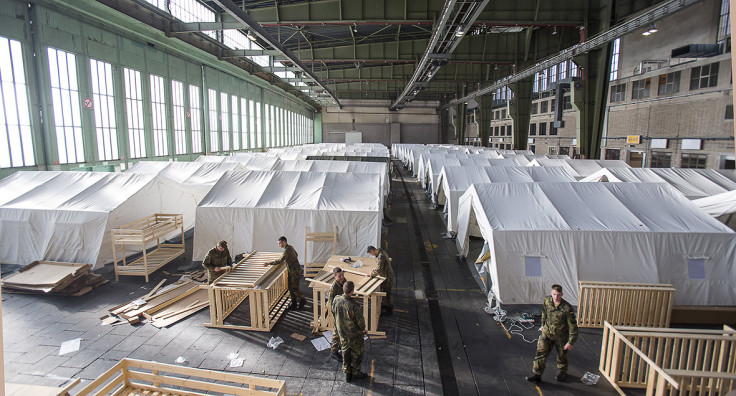The great statistics miracle: Why one million refugees later, German unemployment has not spiked
Where did all the refugees go? Labor Agency data only lists on average 10,000 refugees as unemployed.

Something interesting is afoot in the labour market of the European Union's economic powerhouse Germany. Earlier this month – bar policy wonks, number geeks and pockets of the German media –hardly anyone noticed that the country has neither suffered economic damage nor a spike in unemployment as a result of accepting over 1 million refugees from Syria and Iraq over the past two years. At least on paper, for now.
To say that the mass arrivals dented Chancellor Angela Merkel's popularity would be an understatement. She is expected to suffer political reversals at the hand of the anti-immigration Alternative for Germany party if opinion polls are to be believed.
The German public at large appears unnerved by it too, especially in the wake of a spate of terror attacks, prompting US President Donald Trump to describe Merkel's acceptance of so many refugees as "catastrophic." Even the Chancellor herself has admitted it was a mistake.
Yet figures and how they are tabulated point to a different story. Germany's headline unemployment lurked just over 6% in 2016.
According to the country's Federal Labor Agency (FLA), Germany sees 300,000 people head for retirement per year on average as concerns over its birth rate – the lowest in Europe – persist. In 2016, new job creations and economic growth saw over 430,000 people enter the workforce, and not very many of them were refugees. The bulk of them come from the indigenous applicants or EU citizens.
Its all in the numbers
So where did the refugees go? In fact, the Labor Agency data only lists on average 10,000 refugees as unemployed for much of 2016, with below average numbers for the last three months of last year.
The FLA said: "Not all of the one million refugees the media refers to are available for our labour market. Of that figure, almost a third were 17 years and younger. A small proportion included elderly refugees, and women who would not be actively seeking employment."
However, the agency's preferred system of registering the unemployed also has a big part to play, as official unemployment data only refers to those registered as jobless, and excludes people on training programmes that range from language classes to integration.
As a result these "jobseekers" would stay off the FLA's unemployment registers for a minimum of 2 to 3 years, and longer if a refugee opts to go down Germany's apprentice pathway programme which combines educational courses with training.
Not a quick fix
Timo Klein, senior analyst at IHS Markit, believes it is not a "statistics fudge", just the German way of compiling data. "German statistics agencies as a general rule pride themselves in being independent of political decision-makers. The FLA's work is not evaluated simply on the basis of how many refugees have found work in a set time period, given that this depends largely on the length of the asylum acknowledgement process and the qualification levels of these migrants."
That length of time is far from certain, Klein notes. "The sheer length of time it has taken [and is still taking] to initially register asylum seekers and then to deal with and decide upon the application as such [which can easily take 18 months for those who arrived in Germany in late 2015] means that many refugees are indeed only likely to show up as active job seekers in 2018."
Then there's the matter of legality. A refugee has to be first acknowledged as an asylum seeker, only then can he/she even be considered for language courses and apprenticeships. "Thus, the total time it takes between arriving in Germany and being considered available for the domestic jobs market may well exceed two years," Klein explains.

With 70% of the one million plus refugees who arrived in Germany still either in the "jobseekers" system, or in many cases still to be processed, their absence in the country's employment data can be explained away. It is assisted by the general state of the labour market which continues to be good, with employment in 2016 increasing at more than twice the pace of falling unemployment.
"Furthermore, German labour market reforms of 2003-05 have also included organisational measures to make the work of the FLA much more professional and pro-active [in terms of co-operating with would-be employers] than had been the case 15 years ago. This is now paying off in the context of the refugees," Klein adds.
Patience may not be a virtue
The overall dynamic appears to be healthy, although once trained refugees attempt to enter the German workforce, the situation could change. The Bundesbank's forward projection actually sees the unemployment rate falling to 5.8% in 2018. However, IHS Markit is not as optimistic and predicts an unemployment rate of 6.2%, which the global research outfit suggests would stabilise next year.
Domestic projections suggest Germany's population may fall to 68 million by 2060 from 82.65 million according to latest available official estimates.
Given such parameters, a patient approach of absorbing new, relatively young refugees into its jobs market by investing in their training would not be a problem for Germany unless the economy takes a turn for the worse. However, populist politics of the age might ensure that patience is a luxury rather than a virtue, and statistical methodology is unlikely to rescue the situation.
Gaurav Sharma is the Business Editor of IBTimes UK. He has been a financial journalist for over 15 years, with a core specialisation in macroeconomics and commodities. Follow Gaurav on Twitter.
© Copyright IBTimes 2025. All rights reserved.






















